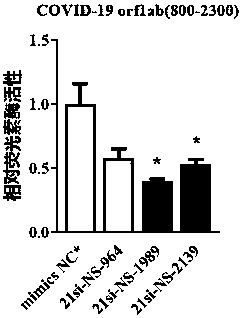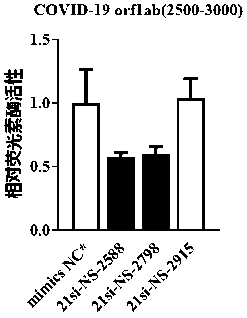Small interfering nucleic acid for inhibiting novel coronavirus, and composition and applications thereof
A new type of nucleotide technology, applied in the field of biomedicine, can solve the problem of lack of effective antiviral drugs for SARS-CoV-2 virus
- Summary
- Abstract
- Description
- Claims
- Application Information
AI Technical Summary
Problems solved by technology
Method used
Image
Examples
Embodiment 1
[0078] Synthesis of small interfering nucleic acids
[0079] The novel coronavirus (SARS-CoV-2) genome (Genebank accession number MN988668.1) (SEQ ID NO: 227) with a relatively conserved sequence was selected as the template. A 21bp nucleotide sequence was selected for the conserved region of the SARS-CoV-2 gene, and a small interfering nucleic acid (siRNA) was designed.
[0080] The siRNA designed in this example was synthesized by Shanghai Gemma Pharmaceutical Technology Co., Ltd., and the sequence of the synthesized siRNA is shown in Table 1.
[0081] Table 1
[0082]
[0083]
[0084]
[0085]
[0086]
[0087] As shown in Table 1, this embodiment also sets the siRNA with the nucleotide sequence of the sense strand as shown in SEQIDNO: 207 and the nucleotide sequence of the antisense strand as shown in SEQIDNO: 208, and the number is M-mimicsNC, which is related to the new coronavirus The virus (SARS-CoV-2) gene has no irrelevant sequence corresponding to ...
Embodiment 2
[0089] Synthesis of Modified Small Interfering Nucleic Acids
[0090] After chemically modifying the sense strand and antisense strand of the sequence in Table 1, the modified siRNA shown in Table 2 is obtained, that is, the nucleosides of bases 1, 2, 3, 19, 20, and 21 of the sense strand The 2' hydroxyl group of the pentose group in the acid residue is all modified by methoxy, the phosphate group between the 1st, 2nd and 3rd bases of the sense chain is a phosphorothioate group, and the sense chain 1st The phosphate group between the 19th, 20th, and 21st bases is a phosphorothioate group; the pentose sugar group in the nucleotide residues of the 1st, 2nd, 3rd, 19th, 20th, and 21st bases in the antisense strand The 2' hydroxyl groups of the antisense strands are all modified by methoxy groups, the phosphate groups between the 1st, 2nd, and 3rd bases of the antisense chain are phosphorothioate groups, and the 19th, 20th, and 21st bases of the antisense strand The phosphate grou...
Embodiment 3
[0098] Dual luciferase reporter gene plasmid construction
[0099] The dual luciferase reporter gene plasmid used in this example is the GP-miRGLO plasmid (the sequence of the empty vector is shown in its manual), which was purchased from Promega, and its map information figure 1 shown. Insert a novel coronavirus (SARS-CoV-2) genome sequence into the GP-miRGLO plasmid to prepare the dual luciferase reporter gene plasmid shown in Table 3.
[0100] table 3
[0101]
PUM
 Login to View More
Login to View More Abstract
Description
Claims
Application Information
 Login to View More
Login to View More - R&D
- Intellectual Property
- Life Sciences
- Materials
- Tech Scout
- Unparalleled Data Quality
- Higher Quality Content
- 60% Fewer Hallucinations
Browse by: Latest US Patents, China's latest patents, Technical Efficacy Thesaurus, Application Domain, Technology Topic, Popular Technical Reports.
© 2025 PatSnap. All rights reserved.Legal|Privacy policy|Modern Slavery Act Transparency Statement|Sitemap|About US| Contact US: help@patsnap.com



